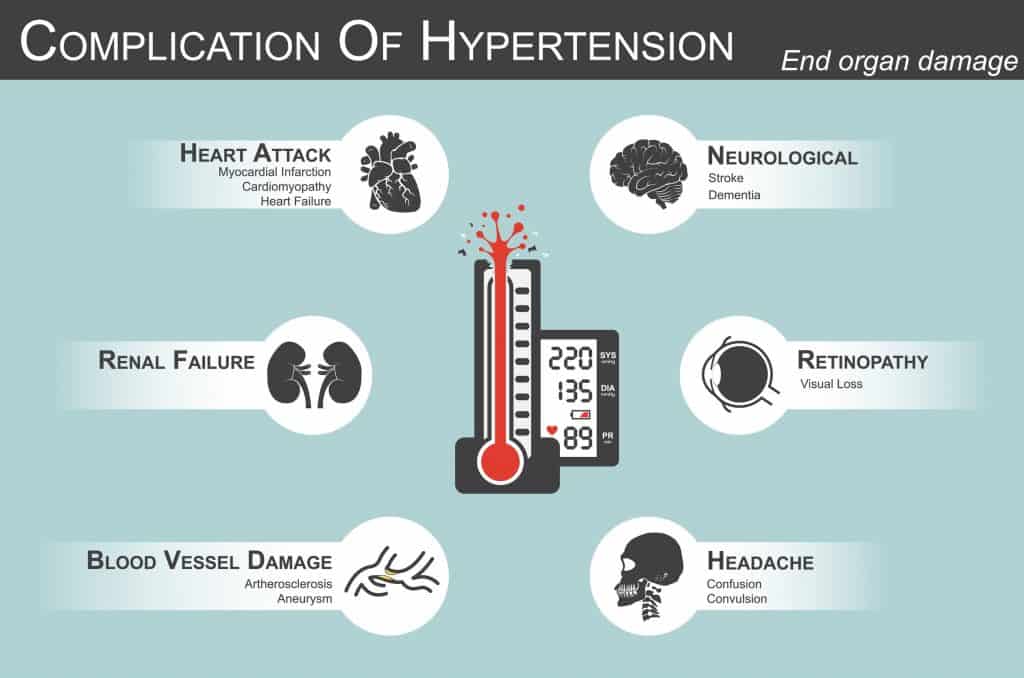

Primary hypertension cases do not have any presenting symptom but instead can lead to long-term health consequences if not treated early in the course of the disease. Hypothyroidism, for example, is characterized by an underactive thyroid gland leading to a decrease in the production of thyroid hormone and can present with weight gain, intolerance to cold, and feelings of tiredness, in addition to elevations in diastolic blood pressure. However, secondary causes of high blood pressure (attributed to an underlying condition) may present with additional presentable symptoms in addition to increases in blood pressure. This is the reason why most medical professionals consider having high blood pressure an asymptomatic disease, having no symptoms. High blood pressure is generally considered a silent disease as it is notorious for not producing many if any, appreciable symptoms. What are the symptoms of diastolic high blood pressure? IDH may also be caused by medications, such as oral contraceptives, corticosteroids or nonsteroidal anti-inflammatory drugs like ibuprofen. This may be especially likely if liver damage occurs since angiotensin is usually degraded in the liver. Chronic excessive alcohol consumption can also lead to IDH. The increased heart rate often seen in people with the syndrome may contribute, as it shortens the time between heartbeats so the blood vessels spend more time exposed to the extra blood flow accompanying each heartbeat.Įxcessive daytime sleepiness is suggestive of sleep apnea syndrome, but a sleep study is required to diagnose the disorder. Sleep apnea syndrome - episodic pauses in breathing during sleep - may also cause IDH by excessive arteriolar narrowing and reduced fluid excretion by the kidneys. Isolated diastolic hypertension can possibly lead to a possible progression of systolic hypertension, which is a predictor of diabetes, stroke, and heart failure. While much emphasis is placed on reducing systolic blood pressure values, elevations in diastolic blood pressure is still a significant predictor of life-threatening consequences.Ī previous study evaluating the medical records of over a million people reported that while elevations in systolic blood pressure were indeed linked to a higher risk of heart disease-related chest pain as well as strokes, high diastolic blood pressure was liked to a great risk of abdominal aortic aneurysm, a condition where the main artery found the abdominal cavity leaks or bursts creating a life threating situation.Īdditionally, other studies found that a link between increases in diastolic blood pressure and cognitive decline. What are the complications of elevated diastolic pressure? Renovascular hypertension, due to narrowing of the main artery leading to the kidneys, is another possible cause of IDH. Most diseases that damage the kidney can lead to IDH by reducing the ability of the kidneys to remove fluids from the body or by increasing the production of angiotensin. Endocrine diseases producing high levels of aldosterone, parathyroid hormone, or corticosteroids can also cause IDH.

Hypothyroidism may be suspected in a person with weight gain, fatigue, and intolerance to the cold, but blood tests are required to confirm the diagnosis. As in primary hypertension, the elevated diastolic pressure is the result of excessive arteriolar narrowing. What are the causes of high diastolic blood pressure?Īn underactive thyroid, or hypothyroidism, is one of the more common secondary causes of IDH. Unusually high levels of certain substances that raise blood pressure, such as angiotensin, or inappropriate contraction of tiny muscles in the arteriole walls are two possible reasons. In IDH caused by primary hypertension, the underlying reason for the arteriolar narrowing is poorly understood. This compresses the blood flowing through the arterioles, thus raising the pressure. In IDH, the diastolic pressure is generally elevated because tiny arteries, called arterioles, in the body are narrower than usual. What is high diastolic blood pressure?ĭiastolic pressure is the force exerted by the blood on the walls of arteries as it flows through these blood vessels between heartbeats. Diastolic Blood Pressure, the second number, is the pressure when the heart relaxes between beats. Systolic pressure is the first number of a blood pressure measurement and reflects the pressure inside arteries when the heart pumps. Lood pressure has two components, systolic and diastolic pressure.


 0 kommentar(er)
0 kommentar(er)
